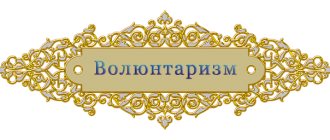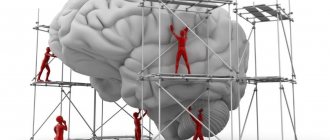Updated July 24, 2021 684 Author: Dmitry Petrov
Hello, dear readers of the KtoNaNovenkogo.ru blog. Most people remember the moral of the fable “The Dragonfly and the Ant”, which is that you can’t always have fun, you need to have time and work. Otherwise, after long idleness, heavy retribution will come in the form of hunger and cold.
In this and his other works, fabulist Ivan Krylov tries to convey to the reader generally accepted rules that should be followed so as not to harm yourself.
Thus, morality represents general provisions designed for all members of society and reflecting the consciousness of the public.
Let's look into this in more detail.
Morality - what is it in simple words?
Brief Definition
The word “morality” has been known to many since childhood. Even before a child hears this term itself, he is already learning to observe moral standards. He is taught how to behave in order to fit into society, not to harm himself and others.
In short, morality is the rules accepted by members of society that must be followed. In simple words, morality is the rules that reflect the moral level of society. Also derived from these rules are norms of behavior in accordance with which members of society should behave.
A broader definition of this concept dates back to ancient times. Morality among the ancient Romans is the most general ideas about what is good and evil, right and wrong, honest and dishonest.
What distinguishes morality from laws?
Inquiring minds often ask the following question. Many aspects of people's lives are regulated through legislation. The basic laws are similar everywhere, regardless of the specifics of the state: for example, they prohibit killing, except in specified cases, for example, killing an enemy on the battlefield. The law prohibits theft, fraud, the use of deception and violence in order to take possession of someone else's property.
That is, a huge part of the norms of behavior in our lives are determined by laws. How does morality differ from them, why is it needed at all? The following answers can be given to this question.
Distinctive features of moral standards
- Universal obligation. Some categories of people cannot be convicted by law, for example, due to their young age or other reasons. Moral norms imply that for a bad deed, everyone who committed it will receive condemnation.
- Voluntariness. Perhaps this is the main distinguishing feature. All residents and guests of the state are required to comply with the law. Compliance with moral standards lies on the conscience of each individual person. It depends on his upbringing and personal qualities, as well as his personal opinion about reasonableness and the acceptable framework of morality.
- The special nature of sanctions for non-compliance. This sign follows from the previous one. If failure to comply with state laws is punishable by criminal or administrative penalties, failure to comply with moral standards is punishable by public censure.
- Inclusiveness. Moral laws apply to everyone - from major politicians to ordinary citizens.
In the dictionary Dictionary of foreign words
and, f.
1. pl. No. Rules of morality, as well as morality itself. A man of high morals.||Cf. ETHICS" title='ETHICS, ETHICS is, what is ETHICS, ETHICS interpretation'>ETHICS.
2. A logical, instructive conclusion from something M. fable.||Cf. APOPHEGMA" title='APOPHEGMA, APOPHEGMA is, what is APOPHEGMA, APOPHEGMA interpretation'>APOPHEGMA (APOPHTEGMA" title='APOPHTEGMA, APOPHEGMA is, what is APOPHEGMA, APOPHEGMA interpretation'>APOPHTEGMA).
3. decomposition Moral teaching, instruction. Read m.||Wed. NOTATION, RACE.
Share the meaning of the word:
Moral standards
The norm, in simple words, is everything that is correct, good and natural. Applicable to the moral sphere of life, this is how one should act and what should be kept in mind as a life guide.
Humanity inevitably changed along the way of its development. Moral guidelines also changed. But in fact, these changes have not been so significant since the times of ancient states. The basic moral norms that operate in modern society arose simultaneously with ancient civilizations. Here they are:
- Politeness . You should never be rude, even when communicating with someone who is lower in status than you. In the modern world, where there are no classes, this applies to all people. Politeness should be observed regardless of whether the interlocutor is older or younger, richer or poorer. Rudeness and rudeness are considered signs of bad manners.
- Prudence . Rash actions are not approved by society. In addition, prudence carries another meaning. One should act in the name of the global good, and not momentary desires.
- Hard work . You should perform your work, household, and family responsibilities efficiently, with dedication and diligence. Not only can laziness lead to conflicts and dismissal, but it is also not encouraged by society as a whole. It is believed that a lazy person is useless to society.
- Justice . Each situation must be judged taking all factors into account. You should not be guided by personal interests.
- Persistence . There are various difficulties in life, but you need to be able to overcome them and not lose heart.
- Temperance . Excessive enjoyment of goods leads to poor results in fulfilling duties.
Morality overt and hidden
Morality, or moral teaching, teaching has existed in literary texts since time immemorial. There were probably no written texts yet, and the parents (and the Boyans-storytellers) vying with each other to give their children riddles on the topic “why did you do this if it was said that you shouldn’t do that”? And the kids squeaked and lied that they had misunderstood. Or maybe they really didn’t understand? Where does the moral in the text come from?
1. In some cases, morality is formulated by the author directly in the text itself. This could be a genre of teachings, instructions, or a fable. The problem is that the further we are from the time of writing, for example, a fable, the more difficult it is for us to understand the semantic connections that led the author to morality. The situation is greatly complicated by cultural differences. Thus, Aesop's fables for the most part contain a moral that causes confusion about its connection with the plot of the fable. It’s easier with Krylov’s fables, but there are difficulties there too (I briefly mentioned this in the blog “The moral of this fable... what?”).
2. Some literary works are “edifying” without a clearly stated moral. “Hidden” moralizing can be so convincing that it is difficult to get rid of the feeling that the author is lecturing and lecturing and will not calm down. I simply cannot read the late L. Tolstoy, some of Gorky’s texts, but here is the early Dostoevsky, Korolenko. Further - more: Merezhkovsky, Gippius, Yesenin, Klyuev, early Blok... I’ll remember a couple of dozen more. But texts from Pushkin and older no longer seem so instructive to me, even if there is a moral directly inserted into the text. Why is that?
I see two reasons.
First: always, in any culture, there are forms associated with evaluations within the framework of “good/bad,” even if the words are neutral in themselves. The word “wing” is neutral, but in conjunction with “stand on a wing”, “spread your wings”, and even the associative “soar like a bird” - definitely have positive connotations and are contrasted with the negative “wingless”, “he does not know the joy of a wing”, or else harsher: “those born to crawl cannot fly.” Moreover, this works mainly for birds, and for airplanes (mechanical objects) - to a lesser extent, since I don’t see a moral assessment in “the wings of the airplane swayed in flight.” That is, moral meanings associated with words and phrases are formed in language. Contemporaries understand them, but non-contemporaries may not notice them.
Second: the reader sees and reads value judgments, depending on his understanding of the context. There are no assessments out of context, even if the author moralizes the entire text to death, but if I don’t see the connection of a word with “good/bad,” for me there will be no morality in the text. And if I am a moralizer in principle, as a type, then for me any text, even a telephone directory, will be a moral judgment (or a fable).
Therefore, one cannot simply talk about morality in a text—the text has a plot, words. Even if the author introduced direct teaching into the text, this does not mean that the text contains morality. It seems to me that it would be more correct to talk about “moralized” forms - about such connections of words in which morality is read depending on the cultural context of the author and reader. It seems to me that it is better not to use such forms unless necessary.
Morality is not in words, not in their meanings, but in meanings (often random), tied to words by the will of circumstances.
———————
Picture: photo by the author (not a self-portrait), alpaca from the farm.
Functions of morality
Now it’s worth answering the question: why are moral standards needed at all? They have five main functions.
- Estimated. It allows you to distinguish evil from good, good from bad, cruel deeds from good. Guided by morality, one can understand whether a person is doing good or bad.
- Regulatory. It implies the creation of new norms and principles in accordance with changes in society.
- Educational. It allows children to form a moral picture of the world and develop their ideas about the norms of behavior in society.
- Control function. Designed to ensure compliance with the rules, and, if necessary, impose sanctions on their violators.
- Integration function. Helps society to be more united by maintaining the same standards and reasonable, kind behavior.
In the dictionary D.N. Ushakova
MORAL, morality, plural. no, female (from Latin moralis - moral). 1. Moral teaching, a set of rules of morality and ethics (book). “It is necessary that the whole task of upbringing, educating and teaching modern youth should be the inculcation in them of communist morality.” Lenin. Bourgeois morality. Principles of morality. | Morality, behavior from the point of view of moral rules. A person of low morals. 2. A moral conclusion from something, a moral lesson. “The moral of the story is this.” Krylov. Hence the moral: no mercy to the enemy! Capital morality (see capital).
Education of morality
From early childhood we begin to be told about what is good and what is bad. Parents and other older relatives, educators and teachers instill moral standards in children. The rest of society also participates in this - by communicating with other children in the team, the child also absorbs certain norms.
How does education and instilling of moral guidelines take place?
- Personal example . The most effective, although underestimated by some, method. By nature, a child is an imitator. This is absolutely normal. In animals, young animals learn exclusively through imitation of adults, and this is also typical for humans. If parents follow moral principles, then the child, looking at them, will try to do the same.
- Morals . By talking with a child about the rules of behavior, you can convey to him much of what he does not understand.
- Art . Books, films and animation, plays and music convey moral standards to children under the guise of exciting stories.
- Personal experience . If a child strives to do the right thing over and over again, and sees that this leads to positive results, he will strive to do so in the future.
The golden rule of morality.
To make it clearer what morality is, let us turn to a rule that, as we reliably know from historical, religious and literary sources, has become widespread in all relatively developed cultures and among all peoples. We are talking about the so-called golden rule of morality. In its most famous form, it reads: “And whatever you want people to do to you, do so to them” (Gospel of Luke 6:31). In a broader ethical perspective of developed morality, the golden rule of morality has a double projection, expanding its potential ethical content. One projection is towards a historically and normatively undeveloped (“inverse”) form. And she points to the talion rule.
What types of education, on the contrary, do not work?
- Moral teachings contrary to personal example. If parents persistently tell their child how bad it is to lie, swear and drink alcohol, and they themselves regularly lie, argue and get drunk, such upbringing will not give a positive result. All methods of education must be integrated and not contradict each other.
- Imposing norms through constant punishments and scandals. The child will strive not so much to observe moral principles because they are correct and good, but rather to strive to avoid punishment. To do this, he will lie and hide his bad deeds.
- Art without analysis. Just showing your child a cartoon about good and evil or reading a book is not enough - he can understand the work in his own way. It is worth talking to him about the meaning of what he saw or heard, to make sure that he understood everything correctly.
Main categories
Morality always includes a number of categories, the concepts of which become fundamental in the life of a particular group of people:
- good;
- evil;
- justice;
- duty;
- dignity.
Rice. 2. Categories of morality
Good
Good is the main value that is identified with moral perfection. This is the key to integrity and harmony of both each individual and society.
Goodness is inherently creative.
Evil
Evil is everything that violates the harmony and integrity of society, as well as that which negatively changes the inner world of the individual and the surrounding order.
Duty
The definition of debt is one of the fundamental ones in the formation of society.
Important! Moral or ethical duty is a person’s choice between what he wants and what he must do.
For example, having given birth to a child, a person is obliged to take care of him until he reaches adulthood. But in fact, he does this much longer, considering it his duty.
Important! A person’s debt is regulated by conscience - this is a person’s personal awareness of his own duty. Whether he follows it or not is determined by a moral choice. This choice is often the most difficult in a person’s life, especially if the options are mutually exclusive.
Justice
Morality considers justice as proportionality in the distribution of benefits and burdens in the lives of members of society. It determines how perfect the way of conducting joint activities is.
Rice. 3. Categories of morality
Justice provides reward for good and punishment for evil.
Dignity
It is one of the highest moral categories, which determines how a person relates to himself, as well as the perception of others around him. A person’s awareness of his own dignity gives him the foundations of self-knowledge and control over his actions.
Dignity determines the level of responsibility of an individual for his actions to himself. It forces her to do things in the name of good and behave in accordance with the standards of her morality.
How to relax mentally?
First of all, it is worth keeping in mind that mental stress is inseparable from physical stress. You have probably noticed that after conflict and difficult mental situations, muscles tense and different parts of the body hurt. The body is the seat of the soul, so moral relaxation includes physical relaxation.
The main way to relax and get rid of tensions at all levels is meditation. It allows you to stop wasting energy on trifles - constantly thinking about situations that cannot be solved immediately, as well as maintaining unnecessary tension.
Proper meditation technique for relaxation at all levels
There are a few things to consider before you start practicing meditation. This practice requires some work, and it is not so easy to master. But those who own it are able to fully relax in 20-40 minutes more than those who don’t – in an entire night of sleep.
For meditation you will need silence and solitude.
- Body position – lying on your back or sitting upright on a chair. In any case, your back should be straight. You need to stretch the top of your head straight, feeling how your spine stretches. The eyes should be closed - the main perception is now tactile. You need to feel the part of the body that relaxes.
- Each part of the body must be felt in turn. Bring all your attention to your right leg. Feel how the muscles relax in it - from the hip to the foot. Repeat the same with your left leg.
- Feel how your hands relax one by one.
- Relax the muscles of your back, abs, chest and shoulders. Feel the tension release from them. Feel that your torso is no longer constrained by the need to constantly hold in an unnatural position.
- Relax your neck and facial muscles.
This meditation requires some practice. One day you will feel like you did everything right. Then your body will be in a state close to weightlessness - as free and relaxed as possible. You will feel that a little more - and soar from the resulting lightness.











